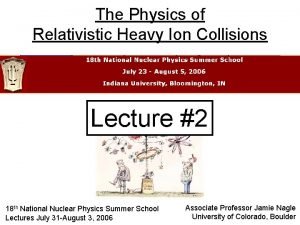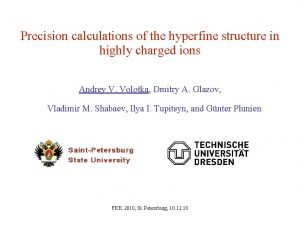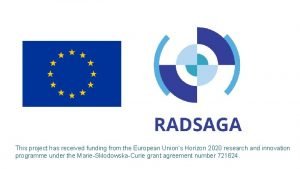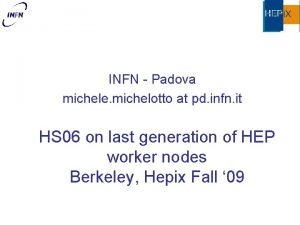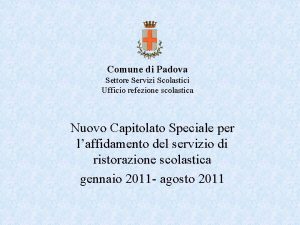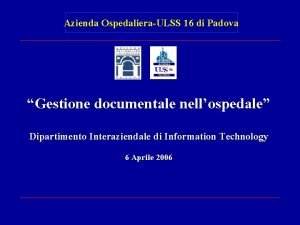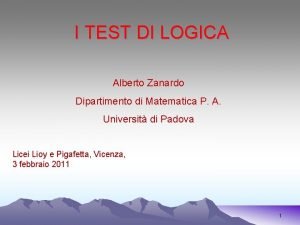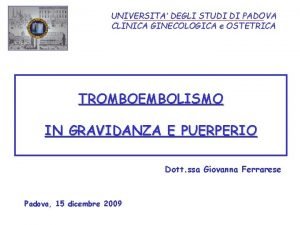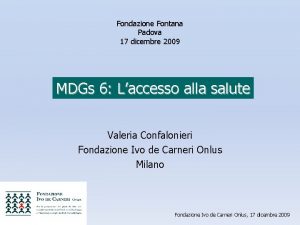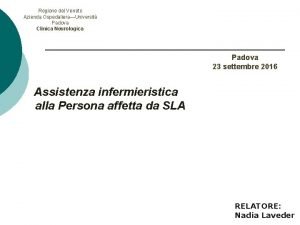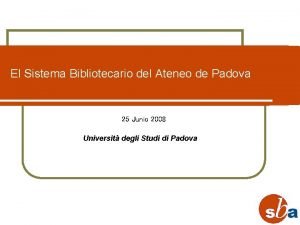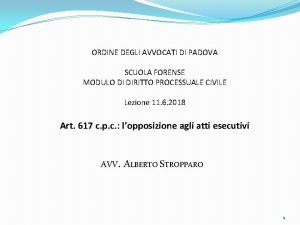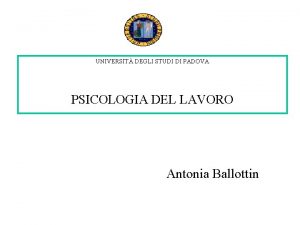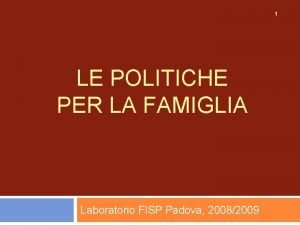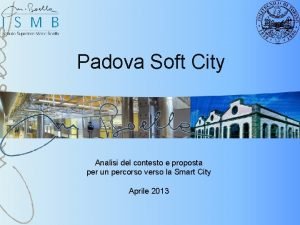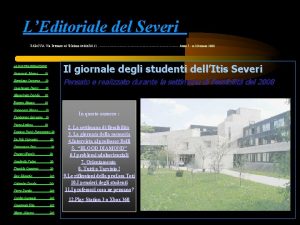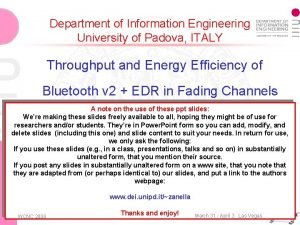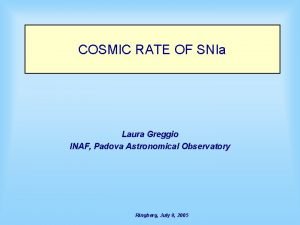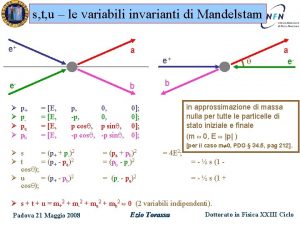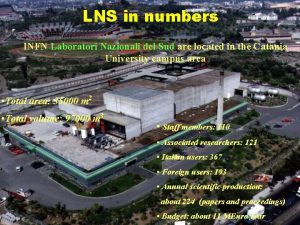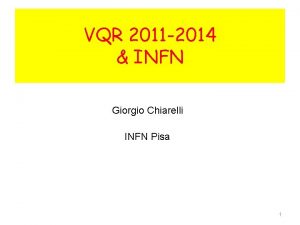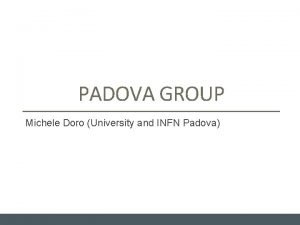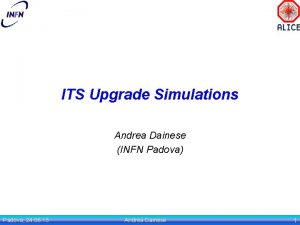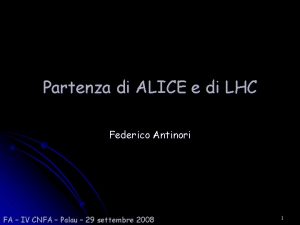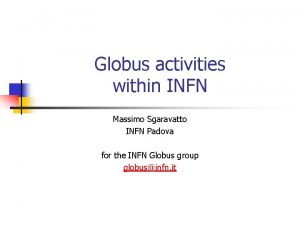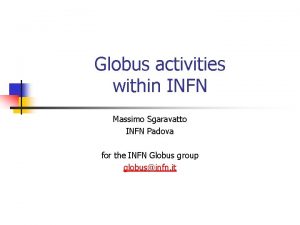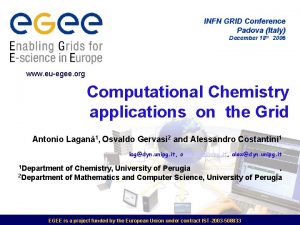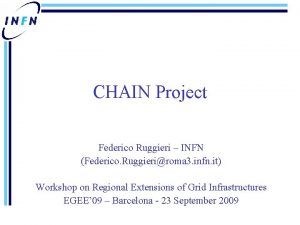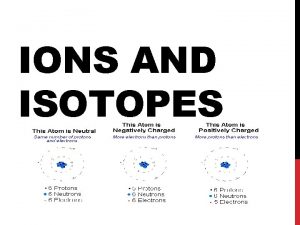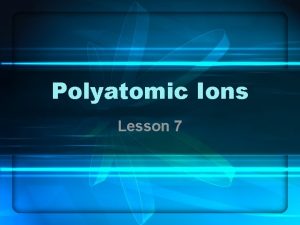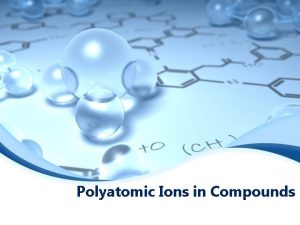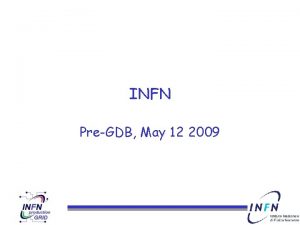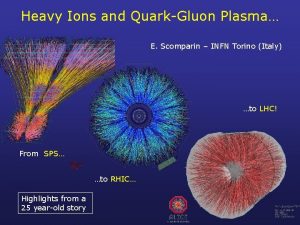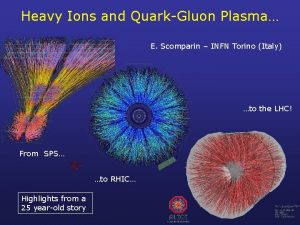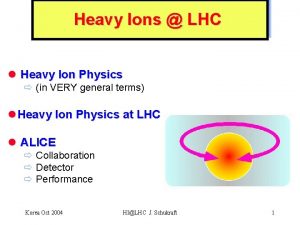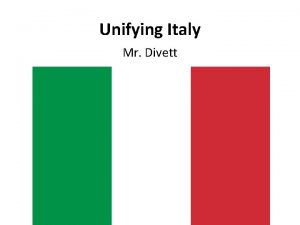Heavy Ions Experiment Federico Antinori INFN Padova Italy








































- Slides: 40

Heavy Ions: Experiment Federico Antinori (INFN Padova, Italy)

A-A collisions in the LHC! John Jowett - LHC Federico Antinori - EPS-HEP 2011 - Grenoble - 25 July 2011 2

Contents • Introduction • Selection of results (hard choices were required…) – – – – Particle multiplicity Correlations High p. T suppression Identified particles Quarkonia Jets Heavy flavours • Conclusions

Introduction

Ultrarelativistic AA Collisions basic idea: compress large amount of energy in a very small volume produce a “fireball” of hot matter: temperature O(1012 K) – ~ 105 x T at centre of Sun – ~ T of universe @ ~ 10 µs after Big Bang • how does matter behave under such extreme conditions? study the fireball properties QCD predicts state of deconfined quarks and gluons (Quark-Gluon Plasma) Federico Antinori - EPS-HEP 2011 - Grenoble - 25 July 2011 5

Lattice QCD l in lattice QCD, non-perturbative problems are treated by discretization on a space-time lattice cure ultraviolet divergences • zero baryon density, 3 flavours • e changes rapidly around Tc • Tc = 170 Me. V: ec = 0. 6 Ge. V/fm 3 • at T~1. 2 Tc e settles at about 80% of the Stefan-Boltzmann value for an ideal gas of q, q g (e. SB) 3 flavours; (q-q)=0 Federico Antinori - EPS-HEP 2011 - Grenoble - 25 July 2011 6

QCD phase diagram ~ 10 ms after Big Bang LHC RHIC Early Universe Quark-Gluon Plasma Temperature Tc ~ 170 Me. V SPS AGS Hadron gas Nuclear matter Baryon density Neutron Star r ~ 5 - 10 nuclear ec ~ 1 Ge. V/fm 3 Federico Antinori - EPS-HEP 2011 - Grenoble - 25 July 2011 7

Geometry of a Pb-Pb collision • central collisions – small impact parameter b – high number of participants high multiplicity • peripheral collisions b – large impact parameter b – low number of participants low multiplicity for example: sum of the amplitudes in the ALICE V 0 scintillators reproduced by Glauber model fit (red): – random relative position of nuclei in transverse plane – Woods-Saxon distribution inside nucleus – deviation at very low amplitude expected due to non-nuclear (electromagnetic) processes peripheral central

Multiplicity

Particle multiplicity for the most central collisions: ~ 1600 charged particles per unit of η ALICE: PRL 105 (2010) 252301 log extrapolation fails (finally!) 2. 2 x central Au+Au (√s. NN=0. 2 Te. V) 1. 9 x pp (NSD) (√s. NN=2. 36 Te. V) √s. NN=2. 76 Te. V Pb+Pb, 0 -5% central, |η|<0. 5 2 d. Nch/dη / <Npart> = 8. 3 0. 4 (sys. ) Federico Antinori - EPS-HEP 2011 - Grenoble - 25 July 2011 10

Centrality dependence • model comparisons ALICE: PRL 106 (2011) 032301 – DPMJET (with string fusion) – HIJING 2. 0 (no quenching) • centrality-dependent gluon shadowing • tuned to multiplicity in 0 -5% – saturation models (sometimes too much? ) Helena Santos - ATLAS • very similar centrality dependence at LHC & RHIC – once corrected for difference in absolute values Federico Antinori - EPS-HEP 2011 - Grenoble - 25 July 2011 11

Correlations

Azimuthal asymmetry … in the transverse momentum distribution of produced particles • why is it important? • non-central collisions are asymmetric in azimuth = angle in the plane of the screen transfer of this asymmetry to momentum space provides a measure of the strength of collective phenomena • Large mean free path – particles stream out isotropically, no memory of the asymmetry – extreme: ideal gas (infinite mean free path) • Small mean free path – larger density gradient -> larger pressure gradient -> larger momentum – extreme: ideal liquid (zero mean free path, hydrodynamic limit) quantified by second coefficient (v 2) of Fourier expansion of azimuthal distribution Federico Antinori - EPS-HEP 2011 - Grenoble - 25 July 2011 13

v 2 • v 2 still large at the LHC • v 2(p. T) very similar at LHC and RHIC system still behaves very close to ideal liquid (low viscosity) same hydrodynamical behaviour? ALICE: PRL 105 (2010) 252302 Federico Antinori - EPS-HEP 2011 - Grenoble - 25 July 2011 14

Structures in (Δη, Δφ) near side jet peak long range structure in η on near side aka “the ridge” two shoulders on away side (at 120 and 240 ) aka “the Mach cone” Helena Santos – ATLAS Federico Antinori - EPS-HEP 2011 - Grenoble - 25 July 2011 15

Fluctuations v 3 • “ideal” shape of participants’ overlap is ~ elliptic – in particular: no odd harmonics expected – participants’ plane coincides with event plane • but fluctuations in initial conditions: – participants plane event plane Matt Luzum (QM 2011) v 3 (“triangular”) harmonic appears [B Alver & G Roland, PRC 81 (2010) 054905] • and indeed, v 3 0 ! • v 3 has weaker centrality dependence than v 2 • when calculated wrt participants plane, v 3 vanishes v 2 v 3 – as expected, if due to fluctuations… ALICE: PRL 107 (2011) 032301 Federico Antinori - EPS-HEP 2011 - Grenoble - 25 July 2011 16

Long-η-range correlations • “ultra-central” events: dramatic shape evolution in a very narrow centrality range • double hump structure on awayside appears on 1% most central – visible without any need for v 2 subtraction! • first five harmonics describe shape at 10 -3 level “ridge” and “Mach cone” – explanations based on medium response to propagating partons were proposed at RHIC – Fourier analysis of new data suggests very natural alternative explanation in terms of hydrodynamic response to initial state fluctuations Federico Antinori - EPS-HEP 2011 - Grenoble - 25 July 2011 Andrew Adare – ALICE (QM 2011) 17

High p. T suppression

Nuclear modification factor (RAA) • RAA: particle yield in AA relative to pp scaled with number of binary nucleon-nucleon collisions • RAA(p. T) for charged particles produced in 0 -5% centrality range – minimum (~ 0. 14) for p. T ~ 6 -7 Ge. V/c – then slow increase at high p. T – still significant suppression at p. T ~ 100 Ge. V/c ! • essential quantitative constraint for parton energy loss models! Yen-Jie Lee – CMS: PAS HIN-10 -005 Federico Antinori - EPS-HEP 2011 - Grenoble - 25 July 2011 19

Suppression vs event plane Alexandru Dobrin – ALICE (QM 2011) • significant effect, even at 20 Ge. V! • further constraints to energy loss models path-length dependence of energy loss (L 2, L 3, …) Federico Antinori - EPS-HEP 2011 - Grenoble - 25 July 2011 20

Identified particles

p. T spectra vs hydrodynamics • comparison of identified particle spectra with hydro predictions – (calculations by C Shen et al. : ar. Xiv: 1105. 3226 [nucl-th]) OK for π and K, but p seem to “misbehave” (less yield, flatter spectrum) Roberto Preghenella - ALICE Michele Floris – ALICE (QM 2010) Federico Antinori - EPS-HEP 2011 - Grenoble - 25 July 2011 22

v 2 vs hydrodynamics • comparison of identified particles v 2(p. T) with hydro prediction Raimond Snellings ALICE (QM 2010) – (calculation by C Shen et al. : ar. Xiv: 1105. 3226 [nucl-th]) again, protons are off… what’s going on with protons? Federico Antinori - EPS-HEP 2011 - Grenoble - 25 July 2011 23

Quarkonia

Quarkonium suppression • Quark-Gluon Plasma “signature” proposed in the 80’s [T Matsui & H Satz, Phys. Lett. B 178 (1986) 416] • in the plasma phase the interaction potential is expected to be screened beyond the Debye length λD (analogous to e. m. Debye screening) • cc and bb states with radius > λD will not bind their production will be suppressed Federico Antinori - EPS-HEP 2011 - Grenoble - 25 July 2011 25

J/ψ @ LHC: forward y, low p. T • LHC: 2. 5 < y < 4, p. T > 0 (ALICE) less suppression than RHIC: 1. 2 < y < 2. 2, p. T > 0 (PHENIX) ~ as suppressed as RHIC: |y| < 0. 35. p. T > 0 (PHENIX) Livio Bianchi – ALICE Federico Antinori - EPS-HEP 2011 - Grenoble - 25 July 2011 26

J/ψ @ LHC: central y, high p. T • LHC: |y| < 2. 4, p. T > 6. 5 Ge. V/c (CMS) prompt J/ψ • Catherine Silvestre – CMS: PAS HIN-10 -006 more suppressed than RHIC: |y| < 1. p. T > 5 Ge. V/c (STAR) LHC |y| < 2. 5, p. T > 3 Ge. V/c (ATLAS) Helena Santos – ATLAS: PLB 697 (2011) 294 inclusive J/ ψ Federico Antinori - EPS-HEP 2011 - Grenoble - 25 July 2011 27

Federico Antinori -Lee EPS-HEP 2011 - Grenoble - 25 July 2011 Yen-Jie – CMS 28

Federico Antinori -Lee EPS-HEP 2011 - Grenoble - 25 July 2011 Yen-Jie – CMS 29

Jets

Di-jet imbalance • Pb-Pb events with large di-jet imbalance observed by ATLAS & CMS recoiling jet strongly quenched! Federico Antinori - EPS-HEP 2011 - Grenoble - 25 July 2011 Frank Ma - CMS 31

AJ • with increasing centrality: enhancement of asymmetric di-jets – with respect to pp & HIJING + PYTHIA Helena Santos - ATLAS: PRL 105 (2010) 252303 Federico Antinori - EPS-HEP 2011 - Grenoble - 25 July 2011 32

Di-jet Δφ • no visible angular decorrelation in Δφ wrt pp collisions e. g. : Frank Ma – CMS: ar. Xiv: 1102. 1957 Federico Antinori - EPS-HEP 2011 - Grenoble - 25 July 2011 33

Jet nuclear modification factor suppression of jet production – in central Pb-Pb wrt binary-scaled peripheral very weak centrality dependence Helena Santos - ATLAS Federico Antinori - EPS-HEP 2011 - Grenoble - 25 July 2011 34

Yen-Jie Lee – CMS Frank Ma – CMS Federico Antinori - EPS-HEP 2011 - Grenoble - 25 July 2011 CMS: ar. Xiv: 1102. 1957 35

Heavy Flavours

c and b quenching @ LHC substantial suppression of heavy flavour production – beauty, too! Diego Stocco – ALICE Catherine Silvestre - CMS [compilation courtesy of Andrea Dainese] study parton mass and colour charge dependence of interaction with medium! Federico Antinori - EPS-HEP 2011 - Grenoble - 25 July 2011 37

D vs π • charm ~ as suppressed as pions • quarks (CR = 4/3) expected to couple weaker than gluons (CR = 3) at p. T ~ 8 Ge. V, factor ~ 2 less suppression expected for D than for light hadrons in BDMPS-ADSW Diego Stocco – ALICE • maybe a hint of RAAD > RAAπ at low p. T … N Armesto et al. , PRD 71 (2005) 054027 to be continued with higher statistics… Federico Antinori - EPS-HEP 2011 - Grenoble - 25 July 2011 38

Conclusions • in November 2010, the field of ultrarelativistic nuclear collisions has entered a new era with the start of heavy ion collisions at the LHC – abundance of hard probes – state-of-the art collider detectors • exciting results already from first, limited data samples – death of ridge and Mach cone? – anomalies in proton yields & momentum distributions – pattern of jet and heavy flavour suppression challenges Eloss models • the future looks very bright – precision measurements constrain dynamic and coupling properties of medium – look out for surprises!!! Federico Antinori - EPS-HEP 2011 - Grenoble - 25 July 2011 39

Merci… • … aux organisateurs for the invitation to present this plenary talk • … à: Peter Braun-Munzinger, Brian Cole, Andrea Dainese, David d’Enterria, Paolo Giubellino, Raphaël Granier de Cassagnac, Barbara Jacak, Peter Jacobs, John Jowett, Karel Šafařík, Carlos Salgado, Jürgen Schukraft, Edward Shuryak, Peter Steinberg, Xin-Nian Wang, Urs Wiedemann, Nu Xu and many others… • … à vous tous Federico Antinori - EPS-HEP 2011 - Grenoble - 25 July 2011 40
 Infn padova
Infn padova Carbon trichloride
Carbon trichloride Heavy ions
Heavy ions Sqed
Sqed Heavy ions
Heavy ions What does ratey stand for
What does ratey stand for Struttura del vangelo di luca
Struttura del vangelo di luca Michelotto padova
Michelotto padova Cinel strumenti scientifici
Cinel strumenti scientifici Department of information engineering university of padova
Department of information engineering university of padova Mechanicistic
Mechanicistic Servizi scolastici padova
Servizi scolastici padova Aopd veneto referti
Aopd veneto referti Zanardo pediatra padova
Zanardo pediatra padova Organigramma comune di padova
Organigramma comune di padova Embricazione coumadin
Embricazione coumadin Istituto comprensivo forte dei marmi
Istituto comprensivo forte dei marmi Fondazione fontana padova
Fondazione fontana padova Department of information engineering university of padova
Department of information engineering university of padova Clinica neurologica padova
Clinica neurologica padova Scuola mantegna padova
Scuola mantegna padova Sistema bibliotecario ateneo padova
Sistema bibliotecario ateneo padova Scuola forense padova
Scuola forense padova Happy fit
Happy fit Moodle unipd psicologia
Moodle unipd psicologia Iniziazione cristiana padova
Iniziazione cristiana padova Student storage padova
Student storage padova Psicologia del lavoro padova
Psicologia del lavoro padova Dai ragazzi padova
Dai ragazzi padova Fisp padova
Fisp padova Soft city padova
Soft city padova Burchiello padova
Burchiello padova Via pettinati 46 padova
Via pettinati 46 padova Amici dei popoli padova
Amici dei popoli padova Information engineering padova
Information engineering padova Laura greggio
Laura greggio Invarianti di mandelstam
Invarianti di mandelstam Scuola donatello padova
Scuola donatello padova Dai ragazzi padova
Dai ragazzi padova Lns infn
Lns infn Giorgio chiarelli infn
Giorgio chiarelli infn


